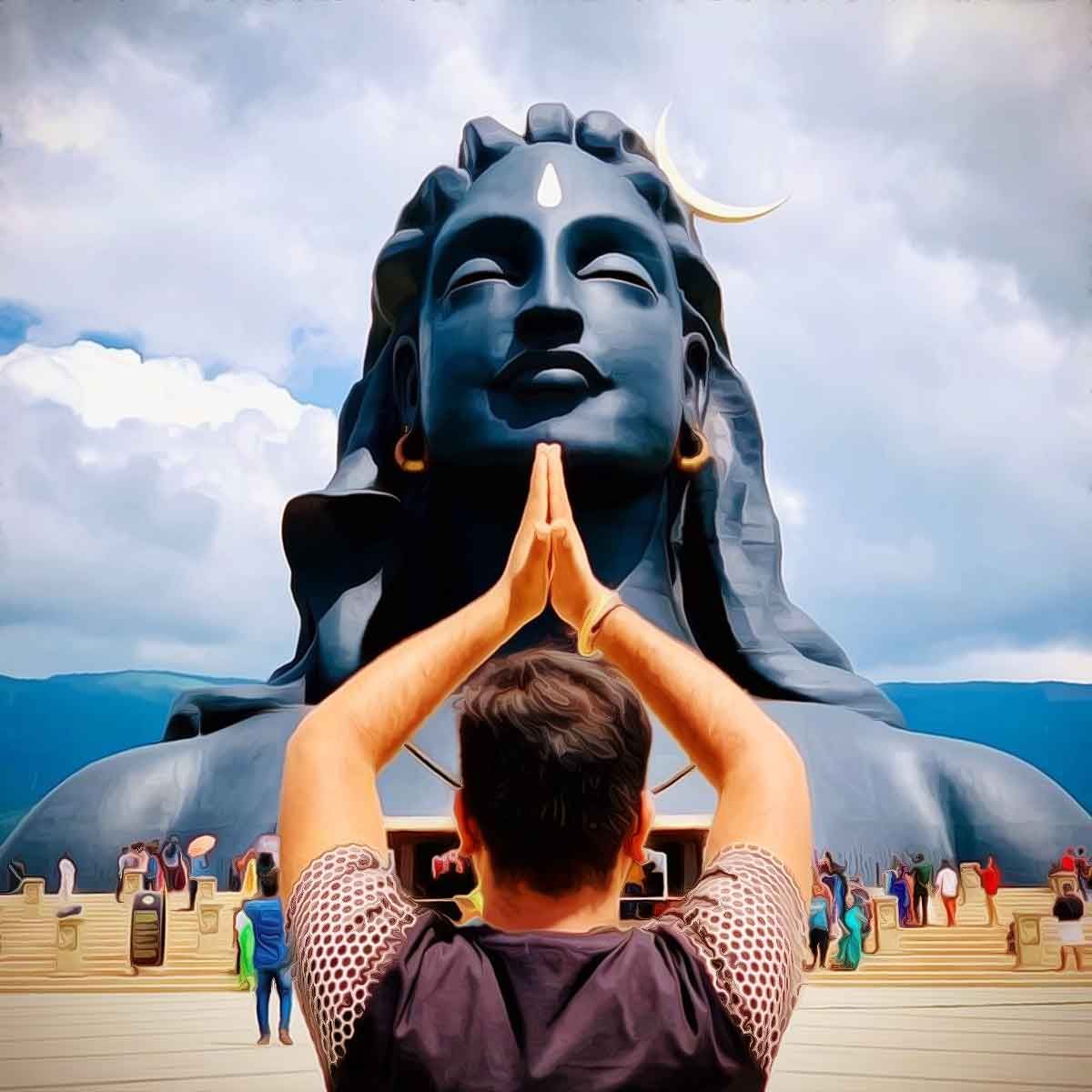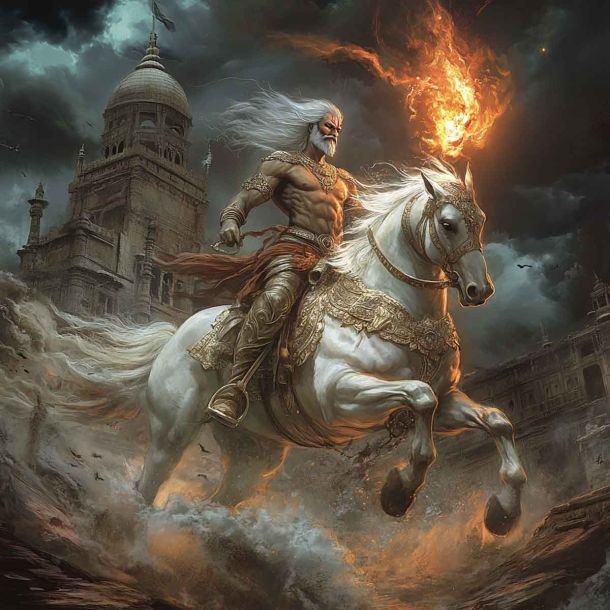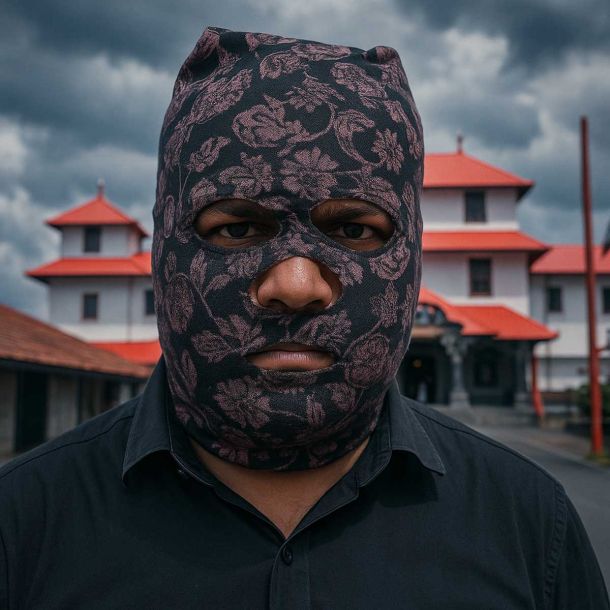More Coverage
Twitter Coverage
Satyaagrah
Written on
Satyaagrah
Written on
Satyaagrah
Written on
Satyaagrah
Written on
Satyaagrah
Written on
Join Satyaagrah Social Media
"Aum Maheshwaraya Namaha": Salutations to the Supreme Person, the boundless Being who wields his triune power for purpose of creation, preservation, and dissolution, the indwelling Spirit within all beings and unseen director of everything

It was Mahapralaya—the night of Brahma when nothing existed. There was neither night nor day, no light or darkness, neither joy nor sorrow. All animate and inanimate creation had merged into the infinite essence. There was neither sun, nor moon, nor planets. The whole firmament was one complete void, pulsating with life.
That alone existed. That which the Vedas call Brahman, the One without a second. That One alone existed—the one Existence, the one Consciousness, the one Bliss—Satchidananda. It is incomprehensible to the mind. It has neither beginning nor end. It has no second. It has no decrease or development. It is immeasurable, changeless, formless, and without attributes. It is the all-pervasive sole cause of the changing universe, filled with forms. That alone existed, and that alone exists. That is the only reality; all else is mythya or illusion. In the course of its own sport, or lila, it emanated out of itself an auspicious form of its own, endowed with all power, qualities, and knowledge. This was the form of Iswara. It is the form of pure sattva (harmony, essence) undiluted by rajas and tamas (gunas, or fundamental attributes of activity and inertia). It is a form that can go everywhere and take on all forms. It sees all and is the cause of all, and it sanctifies everything.
|
In the Puranas, creation is cyclic in nature. A vast period of shrishti, or creation, is followed by another vast period of pralaya, or dissolution. There is no absolute beginning for creation, and thus no absolute end. Time is, therefore, not linear as in modern thought, but cyclic. Brahma is the creative aspect of the Supreme Being. It is he who conducts the work of creation. Shiva is known as the destructive aspect of that same consciousness, and Vishnu is the harmonizer who keeps the balance and sustains creation. A cycle of the creative activity of Brahma is only one day of Brahma, and an equally long cycle constitutes his night. The immensity of Brahma’s life span can be imagined only if we convert it into human years. One human year of 365 days corresponds to just one day of the gods. So 365 human years is only one year for the gods. Twelve thousand such celestial years make one chaturyuga or the four yugas (epochs) into which cyclic time is divided. One thousand such chaturyugas constitute one day of Brahma, and an equal number make his night. Each cycle of creation has its own Brahma, whose total life span is one hundred such years. The immensity of the period of time involved, in human calculations, cannot be imagined. It will come to forty billion plus 311 human years. The human mind can scarcely imagine the period of Brahma’s life. A cycle of creation is only one day to Brahma, and of dissolution, his one night. The inherent tendencies generated by the jivas (embodied souls) in one cycle remain latent during his night and return to that avyaktha from which they have come, and sprout into existence at the commencement of his day.
In every cycle of creation, it is time that commences the act of creation. The first principle to be manifested is the Lord’s power, as time. In itself, time is without any modification. It is insubstantial and without beginning or end. It gets its expression at the beginning of creation when it causes the stirring of the three gunas—sattva, rajas, and tamas—or modes of Prakriti, or nature. Time is the basis of the sport of the Supreme for his creative manifestations. It is without beginning and without end. A period of evolution is followed by a period of involution, called pralaya, in which all things remain in a latent state. At the end of one cosmic cycle, the Lord’s power of illusion, maya, withdraws all things into itself. At the commencement of a new cycle of evolution, the Lord’s power as time starts a new process by which all things come into existence once again. During pralaya, the universe is in a state of latency, and after pralaya, it is in a state of manifestation. This is all a play of the Supreme Lord.
The dissolution of the universe takes three forms based on time, substance, and the attributes of Prakriti. The first is called nitya-pralaya, which is a daily dissolution based only on time, experienced every day by all of us when we go to sleep. Each night is a pralaya for each individual soul. When we sleep there is no world and no individuality; both are in a latent state, submerged into consciousness. The moment someone awakes, the world appears and individuality reasserts itself.
The second type of dissolution is called naimittika-pralaya, or Mahapralaya, which is the night of Brahma, when the Creator, Brahma, goes to sleep. This happens after one day of Brahma’s time, which lasts for a thousand chaturyugas. In the night of Brahma, the Creator sleeps for another thousand chatturyugas and the whole universe goes into a state of involution up
to Satyaloka, or the highest heaven (world of Brahma). After this cosmic night is over, the Lord’s power begins to operate as time, and creation and evolution continue as described at the beginning of this chapter.
The third type of dissolution is called prakritika-pralaya, when all the categories and attributes of Prakriti go into total dissolution into their ultimate cause, Prakriti, which itself reverts into the Iswara and then into the Brahman. This will last for eons, with all things remaining in a latent state. When creation begins once again, all things come out in reverse order. By the fiat of the Absolute, as mentioned earlier, the first to appear in the Lord’s power as time. It stirs the gunas of Prakriti at the beginning of each creative cycle. Next, out of the cosmic womb of Prakriti comes the cosmic ahamkara, or cosmic ego, which splits into the three gunas. The third aspect is the appearance of the tanmatras, or the subtle energy of the elements, which are capable of evolving into the bhutas, or gross elements. The fourth aspect of creation is the projection of the ten indriyas—the five organs of knowledge and the five organs of action. The fifth is the formation of the mind and the presiding deities of the organs, all from the guna of sattva. The sixth is the creation of avidya, or ignorance, which clouds and distorts the minds of living beings.
In his sportive manifestation, Iswara assumes the limitation of rajas and creates, in the form of the Creator, Brahma. From then on it is Brahma who creates all things. In the seventh aspect of creation, Brahma brings into existence the six types of unmoving beings. These are plants that bear fruit without flowering, vegetation that is destroyed when the fruits are destroyed, creepers that climb when supported, the grass family (including bamboo), shrubs that stand without support, and trees with flowers and fruit. Their common characteristics are that they appear insentient but have internal reactions, they come in infinite varieties, and they draw nourishment upward from the roots.
The eighth creation is that of beasts. Tamas are predominant in beasts so they do not think of the morrow and are interested only in food and other physical needs. Their sense of smell is acute. They are without reasoning capacity. There are twenty-eight categories of such species moving on the earth, and twenty-eight flying in the sky.
The ninth creation is that of the human species. Humans are dominated by the guna of rajas and are compelled to act through desire.
Next comes the creation of the gods, or superhuman beings, who are eight in number. Brahma brings into existence these four types of creation at the commencement of every cosmic cycle of creation. The universe existed as it is now even before each pralaya and will continue to exist as it is now after each pralaya. During pralaya, it is in a latent state, and after pralaya, it is in a manifested state; that is the only difference.
The Supreme Purusha is known as Sadashiva, according to the Shiva Purana. He is the Iswara, or supreme embodiment of the godhead, and is of pure sattvic form. Together with his Shakti, or the feminine principle within himself, he decided to create a third one, in order to enjoy the bliss of his own Being. In the nectarine essence of the ocean of his mind, where thoughts were the waves, where sattva was a precious gem, where rajas were the coral and tamas the crocodile, there appeared the most charming of all persons, who appeared to be a veritable ocean of immeasurable majesty. He had the luster of blue sapphire. His glorious eyes were like the newly opened petals of a lotus and were filled with love. He wore silk garments that were golden in color, and he had infinite patience and love.
In a golden, mellifluous voice he asked, “What is my name and my task?” Iswara answered, “As you are all-pervasive and all-expansive, you will be known as Vishnu. You will have many other names as well. By the performance of tapasya (the practice of austerities, including meditation) you will acquire all knowledge.”
Then Vishnu performed severe penance for a thousand celestial years and from his body, water currents of various types began to flow. The twenty-four tattvas, or tangible aspects of creation, also emanated from him. The Supreme Brahman, in the form of divine waters, pervaded the entire void. Vishnu reclined on the body of the celestial serpent and went to sleep on these cosmic waters. Hence he acquired the name Narayana, or the one who reclines on water. Except for that primordial Being, there was nothing else.
Lord Narayana lay alone on his serpent bed absorbed in blissful self-awareness. It was the cosmic slumber in which all creation remained in a subtle state. After a period of a thousand chaturyugas, his power as time stimulated his suspended powers and he opened his brilliant eyes. The whole universe was within him, lying in cosmic dissolution. As his inner gaze turned to these latencies within himself, they burst out of his navel in the most wondrous form of a lotus. It had the brilliance of a million suns, and it illuminated the expansive wastes of the cosmic waters like the rising sun illuminating the quarters—north, south, east, west, northeast, northwest, southeast, and southwest. The all-pervading Being entered the lotus, and immediately there appeared the form of Brahma, who thus came to be known as the lotus-born and the self-born and is the embodiment of the Vedas. As Brahma turned his head in all the four directions, he sprouted four faces, and when he looked up he got his fifth face. His complexion was ruddy. He looked around and saw himself seated on the lotus surrounded by the cosmic waters, knowing neither who he was nor where. The lotus stalk waved to and fro in the midst of the gigantic waves, lashed by the winds of dissolution.
Alone and helpless, he became afraid. “Who am I and where have I come from?”
Thinking thus, he climbed down the stalk for a hundred divine years and could not find its beginning. Despondent, he climbed back up and heard a celestial voice telling him to perform tapasya. Thus for another hundred divine years, he performed severe penance, and then in his purified mind the truth of the Lord as the Indwelling Spirit dawned on him. Brahma had been unable to find this truth in his search in the outside world, for it is only within that this truth can be seen. He saw the Lord Narayana, lying on adishesha, his serpent bed. The serpent’s thousand-jeweled hoods cast their glow over the cosmic
waters, dispelling the darkness. He saw the incredibly beautiful form of the Lord that included within itself the whole universe. His clothes were like the evening clouds covering the mountains. His floral wreaths were made of all the various blossoms of the world. He saw him whose smile removes the sorrows of the world and all his wondrous accouterments. Simultaneously Brahma saw the lotus coming out of the Lord’s navel with himself sitting in it, amidst the turbulent cosmic waters. Seeing that wondrous form of brilliant hue, Brahma was suffused with delight and asked him, “Who are you? Who am I? Pray to enlighten me.”
Lord Narayana enveloped him with his brilliance and said, “Welcome to you, O grandsire. Do not be afraid. I shall confer on you all that you desire.”
Then Brahma, provoked by the quality of rajas, was filled with pride and said, “Who are you to confer anything on me. I am the self-born, the eternal, all-pervasive Brahma, the grandfather of the whole of creation.”
Lord Vishnu said, “I know you as the Creator. For this purpose, you have been born from the lotus, sprung from my navel. But you are not to be blamed for not knowing me. You have fallen prey to my illusion and forgotten your source. Know me to be the Supreme Brahman and the only truth.”
Spurred by the Lord’s power of rajas, terrible anger rose in Brahma’s mind, and he fought a wordy duel with Vishnu. At that moment Sadashiva appeared in the form of a huge column of fire before them, having neither beginning nor end. Both Vishnu and Brahma were bewildered at the sight of this enormous column of fire and decided to seek its source. Vishnu, the soul of the universe, took the form of a boar and sped to the netherworlds in order to discover the origin of that wondrous column. For many aeons Vishnu penetrated the bowels of the universe in this form and thus acquired the name Svetavaraha, or the white boar. At last, exhausted, he returned.
Brahma took the form of a swan and flew toward the top of the column, trying to gauge its summit, but though he soared for many aeons, he failed to see it. He had decided to return and admit his defeat to Vishnu when suddenly he noticed the beautiful keora flower, which is famous in the worship of the gods, drifting down. Although it had been on its downward course for many years, it had lost neither its fragrance nor its luster. Brahma asked the flower where it was coming from and the flower answered that it was coming from somewhere in the middle of that primordial column and had been traveling for vast ages. Then Brahma thought of a perfect way of convincing Vishnu that he had indeed seen the top of that mysterious Being. He asked the flower to accompany him and to swear that it had met him at the top. The flower agreed, and he returned triumphantly. Vishnu took his word, especially since he had a witness to prove the fact. But suddenly out of the column, the mighty voice of the mysterious Lord pronounced these words, “Thou O Vishnu will in the future be considered as equal to me. Thou shalt be worshipped as the Supreme himself.”
Then from that fire appeared the fearful form of Kala Bhairava, who was commanded by Sadashiva to chastise the deceitful Brahma. Bhairava pounced on him and caught hold of his fifth head, threatening to cut it off, but that compassionate and deeply forgiving soul, Vishnu, begged the Lord to forgive Brahma. Sadashiva relented and told the repentant Brahma, “O Brahma, in order to assume the role of Supreme Lord you resorted to deceit. In future, you shall not be honored by anyone and you will not have any temples.” Thus it is that to this day Brahma, the Creator, has no temples or devotees.
Then turning to the keora flower, Sadashiva said, “Due to the fact that you have been an accomplice to this deceit, you will no longer be used in my worship.”
The flower begged for forgiveness, saying, “If I’m not to be included in thy worship, O Lord, the very purpose of my existence will be lost. Pray to forgive me.” Then Sadashiva relented and said that though his words could not be withdrawn, the flower could continue to be used in the decoration of temples. And so it is, to this day.
This column of fire was in the shape of a linga. The word “ linga” actually means “a sign,” or a characteristic. Brahman, the cosmic spirit, has no linga, but since the mind needs something concrete to hold on to, Shiva is depicted in the form of the linga. Shiva’s linga is the divine phallus, the source of the seed of the cosmos, containing within it the entire universe of living and nonliving beings. All life is created from it and returns to it. The yoni, or sign of the female, forms the base of the linga and together they represent the union of man and woman, Shiva and Shakti, the cosmic spirit combined with the cosmic Prakriti, or nature, through which the whole of creation comes into being. Usually, a pot of water is suspended above the linga in order to cool it, since its origin is the fiery linga that stretched to infinity and whose nature none could fathom.
The day on which Sadashiva thus manifested as a column of fire was the day on which the constellation Ardhra was in ascendance, in the month of Margashirsha, November/December. Those who worship Shiva on that day will be blessed. The place where that great Being manifested himself as the column of fire was on the hill of Arunachala, where a holy center of worship sprang up over the course of time.
To Brahma and Vishnu, who had been humbled, Sadashiva explained, “I am the Supreme Brahman. My form is both manifest and unmanifest. I am both Brahman and Iswara. My form as Iswara can be known through all the forms of the various deities, and my form as Brahman can be known through this formless linga. Shiva can be worshipped through his formless aspect as the linga, as well as his aspect with form. All other gods, including both of you, will have aspects with form.”
When Shiva takes on a form, he has five faces corresponding to his five powers of creation, maintenance, annihilation, concealment, and liberation. The syllable “A” comes from the northern face, the syllable “U” from the western, the syllable “M” from the southern, and the bindu, or dot, from the eastern face. The nada, or cosmic sound, comes from the middle face. These five all unite to form the mystic sound of aum. From these five sounds is born the five-syllabled mantra, “Na·ma-shi·va·ya.” Aum indicates all knowledge, and the entire set of mantras and all the four Vedas have sprung from it. Different things are achieved by different mantras, but Omkara (the sound of aum) alone achieves everything. Through repetition of this root mantra, both enjoyment and salvation can be attained.
|
At that time, AUM, the sound of eternity, which is the form of the Lord as nada, or sound, filled the air in every quarter. It filled the hearts of Brahma and Vishnu with indescribable bliss. The sound manifested in a luminous form before the clear gaze of Vishnu, who was pure and free from all negative thoughts. The first syllable “A” blazed like the sun to the right of the column of fire, then the sound “U” appeared in the middle, and finally, the sound “M,” glittering like the lunar sphere, appeared to the left. Enveloped by that sound Vishnu meditated on the universal Being and asked to examine the column of fire once again. The truth was revealed to his calm mind. The column of fire was the Supreme Brahman. Nada is one of his forms. The sound “A” is expressed by the Creator or Brahma; the sound “U” is expressed by the Enchanter or Vishnu, and the sound “M” by Rudra or Shiva.
|
Both Brahma and Vishnu eulogized the Great Supreme. “Obeisance to thee, of the bodiless form. Obeisance to thee, of the formless luster. Obeisance to thee, Lord of everything. Obeisance to thee as the perfect sound, aum.” Thus they praised their preceptor and prayed that he would take on a form that could be worshipped. The voice said that he would incarnate through the body of the Creator, Brahma, and would be known as Rudra; Shiva and Rudra would be the same principle. The voice also declared that Brahma should engage himself in the work of creation, and Vishnu, of protection. Rudra would be the cause of dissolution. Vishnu would be the bestower of salvation on all. In order to please Brahma and Vishnu, Sadashiva took the form of Dakshinamurthy, the preceptor of the world. He faced south, or dakshina, while Brahma and Vishnu faced north. He placed his lotus hands on their heads and slowly taught them the great mantra and the supreme knowledge.
The Iswara’s Shakti, or power, manifested in three forms: As Saraswati, goddess of speech, she became the consort of Brahma; as Lakshmi, goddess of wealth, she was to become the wife of Narayana or Vishnu; and as Kaali, she would stay with Rudra.
The voice continued, “Know Me to be the Supreme Brahman, the eternal, the endless, the perfect, and the unsullied. Vishnu has tamas within but sattva outside; he will be the protector and sustainer of all the worlds. Brahma, who creates, will have rajas both within and without, and Shiva, who causes dissolution, will have sattva within but tamas outside. This is the position of the gunas in the three deities. O Vishnu! Spread your glories far and wide by taking up various incarnations. Remember that there is no difference between you and Shiva. He who worships you worships Shiva and vice versa.”
Both Brahma and Vishnu again eulogized the form that now disappeared from view. Brahma looked around to find that he was alone once more and was puzzled as to how he should proceed with the work of creation. So he meditated once again on Vishnu, who appeared before him in all his glory. When Brahma told him of his predicament, Lord Vishnu blessed Brahma and told him that the knowledge of creation would come automatically to him. He would be able to create all things without any external aid, for everything was contained in seed form within the lotus on which he was seated.
Brahma now created the seven sages: Marichi from his eyes, Brighu from his heart, Angiras from his head, and Pulaha, Vasishta, Kratu, and Daksha from his vital breath. Narada was created from his lap and Kardama from his shadow. Dharma (righteousness) came from his right breast. From his back came adharma, or unrighteousness, which is the seat of death, the terror of the worlds. From his heart came desire; from his eyebrows, anger. From his lower lip came greed and from his mouth, speech. From his urinary tract came all the oceans and from his anus the spirit of evil. From his mind were born the four boy sages known as Sanaka, Sanandana, Sanatana, and Sanatkumara. He begged them to proceed with the task of creation, but these pure souls were ever established in atomic consciousness (identification with all life) and refused to obey their father. At this disobedience on the part of his offspring, Brahma frowned with rage, and from that frown there appeared a boy with a ruddy complexion. He cried out, “O father, give me names and places of positions.” Because he cried as soon as he appeared, Brahma called him Rudra, which means “don’t cry.” This is the story as given in the Bhagavatha Purana. Brahma gave him eleven names and forms, along with appropriate consorts, and told him to create. Unfortunately, Rudra’s creations were as fierce-looking as he was, so Brahma told him to stop creating. He told him to do tapasya, and thus Rudra did tapasya and came to be known as Shiva, or the auspicious one.
Since the work of creation was not progressing at all, Brahma prayed to the Divine to help him. At that time his body became divided into two halves, one of which was a man, called Swayambhu Manu, and the other a woman, called Shatarupa. They became husband and wife, and from that time onward, creation proceeded by way of sexual relationships.
O Resident of the mountains! We sing this hymn to you to propitiate you. Be pleased to make our world prosperous, our minds peaceful, and our bodies free from disease - “SRI RUDRUM,” YAJUR VEDA
Let the blue-necked one make us happy, He who rises in crimson splendor in full view of the cowherds, the water maidens, and the creatures of the world - “SRI RUDRUM,” YAJUR VEDA
O thousand-eyed One! O many quivered One! May you be pleased to unstring your bow, flatten the tips of your arrows, and become peaceful and well disposed toward us - “SRI RUDRUM,” YAJUR VEDA
Let the arrows of your bow liberate us from pain and your quiver be directed against our enemies - “SRI RUDRUM,” YAJUR VEDA
Aum Namashivaya! Aum Shambave Namaha!
References:
Shiva Stories and Teachings from the Shiva Mahapurana - By Vanamali
 Support Us
Support Us
Satyagraha was born from the heart of our land, with an undying aim to unveil the true essence of Bharat. It seeks to illuminate the hidden tales of our valiant freedom fighters and the rich chronicles that haven't yet sung their complete melody in the mainstream.
While platforms like NDTV and 'The Wire' effortlessly garner funds under the banner of safeguarding democracy, we at Satyagraha walk a different path. Our strength and resonance come from you. In this journey to weave a stronger Bharat, every little contribution amplifies our voice. Let's come together, contribute as you can, and champion the true spirit of our nation.
 |  |  |
| ICICI Bank of Satyaagrah | Razorpay Bank of Satyaagrah | PayPal Bank of Satyaagrah - For International Payments |
If all above doesn't work, then try the LINK below:
Please share the article on other platforms
DISCLAIMER: The author is solely responsible for the views expressed in this article. The author carries the responsibility for citing and/or licensing of images utilized within the text. The website also frequently uses non-commercial images for representational purposes only in line with the article. We are not responsible for the authenticity of such images. If some images have a copyright issue, we request the person/entity to contact us at This email address is being protected from spambots. You need JavaScript enabled to view it. and we will take the necessary actions to resolve the issue.
Related Articles
- The Untold Story of the Brave Maratha Warrior Queen Ahilyabai Holkar!
- Unsung Heroine Pritilata Waddedar, Who Shook The British Raj at the age of 21
- रामचरितमानस एवं उसके अंग्रेजी अनुवाद तथा हिंदी के अकेडमिक्स का दोहरा रवैया
- The Forgotten Story of Rani Abbakka Chowta, the Fearless Warrior Queen of Tulu Nadu
- Righteousness vs Loyalty: Prince Rama obeys his father and leaves the Ayodhya kingdom
- "पितृ पक्ष": Amidst the chaos of modernity, the timeless ritual of ancestor worship stands firm, bridging the past & present, not mere tradition; its the soul's whisper, echoing gratitude & seeking blessings from those who once tread the paths we now walk
- "Where there is great belief, there are always miracles": 110 years old Siyaram Baba still reads Ramayana without glasses, had donated Rs 2.5 cr for repair of Narmada Ghat, Indian sages have surprised whole world with the power of yoga and meditation
- Kartar Singh Sarabha - The Freedom fighter who was Hanged at the age of 19 and inspired Bhagat Singh
- BHU starts India's first Hindu Studies course with topics on ancient warfare, military strategy, women in military
- How Chhatrapati Shivaji Maharaj was establishing Hindu Samrajya by concluding centuries of Islamic oppression - Historian GB Mehandale destroys secular propaganda against Hindu Samrajya Divas
- Mangaluru Kambala: Reinstating Traditions One Race At A Time
- "The soul passeth from form to form; and the mansions of her pilgrimage are manifold": 'Aarti' performed at Shri Amarnath Cave Shrine in Jammu & Kashmir, first batch of pilgrims started its journey towards the cave shrine, 60,000 security forces deployed
- "The Rishis - Spiritual Scientists at the Dawn of Time": Ones who gave us heritage, culture, and way of life, the Sanatana Dharma, for whom time is a continuous river, so they pass from Satya Yuga to other yugas with ease as if floating on cloud of time
- ‘Lord Shiva helps creation sprout even from ruins, Humanity always wins over terrorism’: PM Modi launches key projects at Somnath
- Jagannath Temple administration issues clarification on proposed sale of temple lands
























